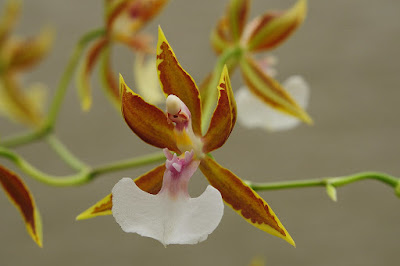Oncidium cariniferum is found in Costa Rica and Panama. It grows on larger branches in lower montane forest at elevations of 1000 to 2400 meters above sea level.
Oncidium cariniferum also called as The Keeled Oncidium, Collare-stuartense cariniferum, Miltonioides carinifera, Odontoglossum cariniferum, Odontoglossum hastilabium var. fuscatum, is a species of the genus Oncidium. This species was described by Johann Georg Beer in 1854.
IDENTIFY ONCIDIUM CARINIFERUM ORCHID PLANT
Oncidium cariniferum is found in Costa Rica and Panama. It grows on larger branches in lower montane forest at elevations of 1000 to 2400 meters above sea level.
It is a medium sized, cool to cold growing epiphyte with sulcate, ovoid, compressed, 9-12 cm long pseudobulbs subtended by foliaceous bracts with 2 apical, coriaceous, elliptic-lanceolate, conduplicate at the base leaves.
The Keeled Oncidium blooms in the spring, fall and winter on a erect or arching, 120 cm long, branched, many flowered, paniculate, fractiflex inflorescence arising on a mature pseudobulb with narrowly ovate-triangular, acute floral bracts. Sepals and petals 3 cm long, greenish outside, but of a purplish-brown inside, distinctly keeled at the back. Lip yellowish-white, sessile, ligulate at its base, but suddenly changing into a broad reniform plate, which is apiculate in front, and at its base adjoins the crest, which consists of 2 nearly prostrate, irregularly toothed, rhomboid lobes on either side, with 3 finger-like processes in front. Column elongated, with transparent crenulate wings, its anther-bed scarcely margined.
ONCIDIUM CARINIFERUM ORCHID PLANT CARE AND CULTURE
Cultural information should only be used as a guide, and should be to be adapted to suit you. Your physical location; where you grow your plants, how much time you have to devote to their care, and many other factors, will need to be taken into account. Only then can you decide on the cultural methods that best suit you and your plants.
Light:
Oncidium cariniferum need a light level of 10000-15000 lux for mature plants, but less for young plants and when temperatures are high (70% shade cloth over summer and more light in winter). Leaves turn reddish blue if receiving too much light and leaf loss will occur if too sun damaged. Dark green leaves indicate insufficient light. A slight bronzing of the leaves and older bulbs indicates the light is good for flowering.
Temperature:
The Keeled Oncidium can be grown under cool and cold temperature conditions. In summer, the optimum temperature range is between 8°C and 26°C. In winter, it need a minimum nighttime temperature of 4 to 13°C, with daytime temperatures of 10 to 17°C. In their natural environment night temperatures can fall to 5°C and although tolerant of low temperatures down to 0°C, they will not tolerate frosts.
Humidity:
This orchid prefer humidity levels between 55-75%; higher levels of 60-80% require good air movement especially in the cooler months. Plants can also tolerate humidity levels down to 40% which can be maintained or increased with morning and evening misting.
Substrate, growing media and repotting:
Oncidium cariniferum are usually grown in pot using small bark (5-10mm) perlite potting mix (5:1) or in sphagnum moss and perlite (70:30) as substrate. Some growers place a layer of sphagnum moss on the top of the pot to reduce evaporation and keep the roots cool. They can also be grown in perlite with a layer of gravel on the top.
These plants should be repotted every year to every 2 years in spring or autumn when new growths are about half mature. They should be grown in small squat pots that allow more frequent watering. The base of the new growth should be planted about 1.5cm into the bark but no deeper. Keep bark barely moist until new roots appear then resume normal watering.
Watering:
The Keeled Oncidium like abundant water and require frequent watering in warmer months. They must never be allowed to dry out. During summer irrigation will be required every 2 -3 days, however during winter rates may drop to once every 10 – 14 days. Misting daily in very hot weather is recommended. To reduce leaf spotting, avoid watering in the heat of the day or late afternoon in warmer months. Also avoid wetting the leaves and water the pot, not the leaves.
Fertilizer:
This plant require frequent application of half to quarter strength fertilizer all year round but less in winter. Apply fertilizer every 2 weeks when growing actively but monthly when less active. They are not gross feeders and too much fertilizer will harm their roots and turn leaf tips brown. Use of high phosphorus or potassium fertilizers as plants approach flowering can increase flower count and substance.
Rest period:
Oncidium cariniferum do not a rest period to stimulate flowering nor in winter. But they need less water in the winter, especially if they grow under the conditions of a dark, short day that occurs in moderate latitudes. You can let the plants dry between the next watering, but you must not let the plants stay dry for a long time. Fertilization should be limited or should be completely abandoned until spring, when stronger watering resumes.

















COMMENTS